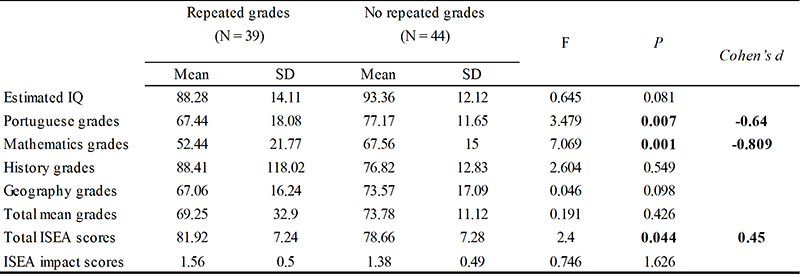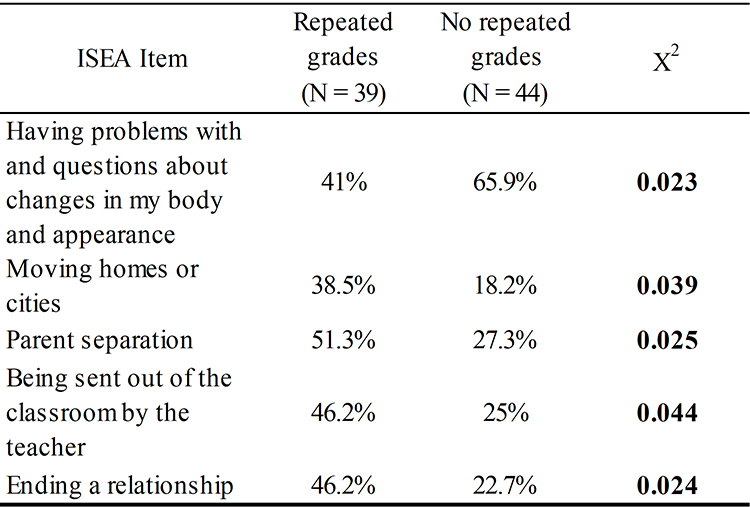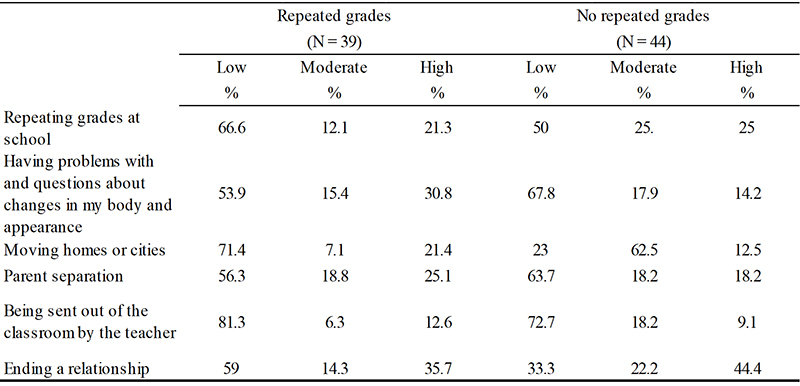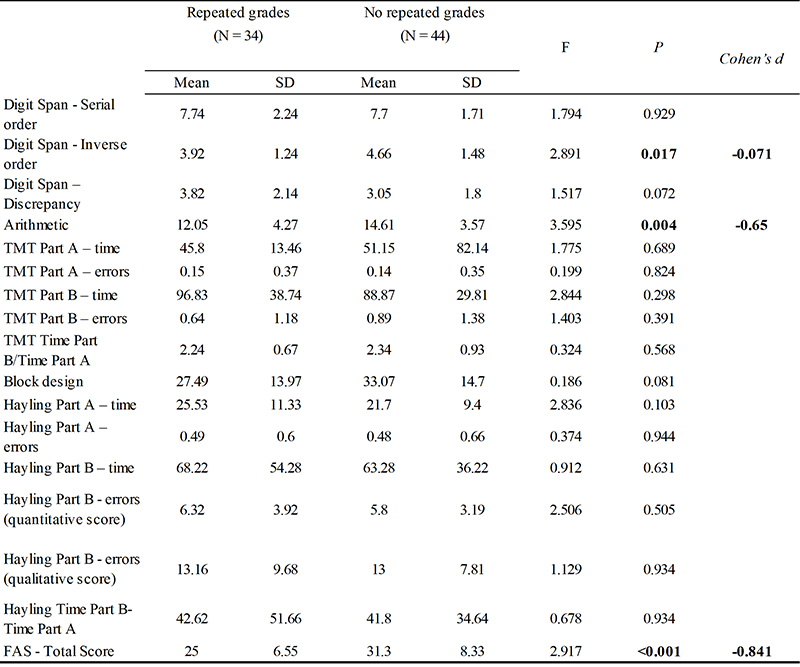Exposure to stressful life events may have a negative impact on emotional, cognitive, and academic development in children and (Carter & Garber, 2011; Cicchetti, 2012; Fishbein et al., 2009; Maguire et al., 2015; Pechtel & Pizzagalli, 2011). Some studies have found associations between exposure to such events and a higher incidence of mood disturbances (Boardman, Alexander, & Stallings, 2011; Reyes-Rodríguez, Rivera-Medina, Cámara-Fuentes, Suárez-Torres, & Bernal, 2013). Studies suggest that 60 to 90 percent of the general population has been exposed to at least one financial, family, social, or psychological stressful event, and considers the event to have been traumatic (Breslau et al., 1998; Kristensen, Parente, & Kaszniak, 2005). Among students, the likelihood of exposure to a stressful situation may range from 10 to 90 percent depending on the type of event considered (Agustini, Asniar, & Matsuo, 2011; Smyth, Hockemeyer, Heron, Wonderlich, & Pennebaker, 2008; Yeager, Lee, & Jamieson, 2016).
The impact of such an occurrence is determined not only by the features of the event itself but also by how it is appraised, as studies have found significant differences in the way individuals react to a same situation (Poletto, Kholler, & Dell´Aglio, 2008; Yeager, Lee, & Jamieson, 2016). In adolescence, individuals do not yet have an adequate repertoire of coping skills, so that exposure to situations of high tension can lead to high levels of stress (Busnello, Schaefer, & Kristensen, 2009; Lang et al., 2016).
A study found that the most frequently reported stressful events in adolescence were arguments with friends, exams at school, obeying parents, death of a relative (not parents or siblings), and fights with siblings (Kristensen, Leon, D’Incao, & Dell’Aglio, 2004). According to some authors (Hostinar, Johnson, & Gunnar, 2015; Poletto et al., 2008), most of the stressful events experienced by children and adolescents are family or school related. Other frequently mentioned stressors that occur outside of these environments include life changes, the end of significant relationships, and illnesses among friends or family (Reyes-Rodrigues et al., 2013).
Stressful life events in childhood have been shown to have an important impact on cognitive and academic performance (Fishbein et al., 2009; Spann et al., 2012; Weidmana, Augustineb, Murayamac, & Elliote, 2015) and to influence learning abilities (Romano, Babchishin, Marquis, & Fréchette, 2015; Sbaraini & Schermann, 2008). A study by Pereira, Santos, and Williams (2009) found that children exposed to maltreatment had worse school performance than non-exposed peers in the same grade, and of the same age and gender. According to some longitudinal studies, chronic exposure to maltreatment may have a significant impact on mathematical, reading, and writing abilities in children and adolescents (Coohey, Renner, Hua, Zhang, & Whitney, 2011; Friedel et al., 2015). Violent and aggressive family structures have been shown to be associated with lower grades, grade repetition, and school absenteeism in children and adolescents (Kiesela, Piescherb, & Edlesonc, 2016; Wildin, Williamson, & Wilson, 1991).
A review of the literature showed that few studies have investigated the association between exposure to stressful life events, executive functions, IQ, and grade repetition, which suggested a need for further studies on the topic. Therefore, the aim of the present study was to compare the frequency of stressful life events, academic performance, and executive functions between adolescents with and without a history of grade repetition. The present study also compared the most frequently reported stressful events and the appraisal of the intensity of these occurrences between groups of adolescents with and without a history of grade repetition.
Method
Participants
The study was conducted on 81 adolescents, drawn from the sample of 613 participants who were assessed as part of the National Postdoctoral Program (PNPD) of the Postgraduate Psychology Program of the Pontifical Catholic University of Rio Grande do Sul (PUCRS), which investigated the effect of childhood maltreatment on cognition and psychopathology in adolescence, adulthood, and old age. Participants were recruited from seven public middle and high schools in the city of Porto Alegre. All seven schools offered complete middle and high school programs. In each school, one class per grade level (from 6th grade to the last year of high school) was randomly selected for study participation.
Data for the PNPD study was collected using self-report instruments, including a sociodemographic information questionnaire and the Brazilian Economic Classification Criteria (ABEP, 2008). Participants were collectively assessed in their own classrooms or in other quiet locations designated by the school.
After taking part in the PNPD study, some individuals were selected by convenience sampling to participate in the present study. Eighty-three of the individuals sought for participation agreed to take part in the study, and these individuals were divided into two groups: 39 participants who had repeated at least one grade level (case group) and 44 individuals who had not repeated any grades. Inclusion criteria for the case group were: (a) history of grade repetition, (b) agreeing to take part in the study and participation authorized by parents or guardians, and (c) age between 12 and 18 years. Participants in the control group were selected using the following criteria: (a) no history of grade repetition, (b) agreeing to take part in the study and participation authorized by parents or guardians, and (c) age between 12 and 18 years. Individuals in both groups were matched by grade level and sex. The following exclusion criteria were applied: (a) presence of severe mental disorders, symptoms of psychosis or severe mental disability detected during the interview. No individuals in the sample were excluded from participation in the study.
Instruments
Sociodemographic information questionnaire
Investigates sociodemographic variables such as age, sex, grade level, number of siblings, number of grade repetitions, parental age, and living arrangements.
Brazilian Economic Classification Criteria
This instrument assesses socioeconomic status and the educational level of the head of the household, and is scored according to the Brazil Criteria (ABEP, 2008).
Arithmetic and Digit span Subtests of the Wechsler Intelligence Scale for Children (WISC-III) or Wechsler Adult Intelligence Scale (WAIS-III)
Individuals aged from 12 years to 15 years and 11 months were administered the WISC-III (Wechsler, 1997; Nascimento, 2004), while participants with ages ranging from 16 years to 18 years and 11 months were administered the WAIS-III subtests (Nascimento, 2004). The Arithmetic subtest assesses mental calculation, comprehension of complex verbal instructions, reasoning abilities, and working memory capacity. The Digit Span subtest is a two-part instrument designed to assess working memory capacity (Wechsler, 2005).
FAS Oral Word Association Test
This is a measure of verbal fluency which assesses executive functioning (Strauss, Sherman, & Spreen, 2006).
Trail Making Test (TMT)
This two-part test measures attention, inhibition, cognitive flexibility, visual processing speed, and motor ability (Lezak, Howieson, & Loring, 2004).
Hayling Test
This task mainly assesses initiation speed and inhibitory control (Abusamra, Miranda, & Ferreres, 2007). The version of the Hayling Test used in the present study was adapted to the Brazilian population and its normative data are currently being collected (Fonseca et al., 2010).
Intelligence assessment
A brief assessment of intelligence was conducted using the Block Design and Vocabulary subtests of the WISC-III or WAIS-III (Wechsler, 1997; 2005; Nascimento 2004).
Inventory of Stressful Events in Adolescence
Stressful life events were assessed using an adapted version of the Inventory of Stressful Events in Adolescence (ISEA; Ferlin, Lima, Alchieri, Kristensen, & Flores, 2000).
School report cards
Academic performance was assessed by the final grades obtained each year in the following subjects: Portuguese, Mathematics, History, and Geography. Subjects are graded on a scale ranging from 0 to 10. Grade repetition was assessed with a question in the sociodemographic information questionnaire completed by participants as part of the the PNPD study.
Procedure
Data collection
The present study was approved by the Scientific and Research Ethics Committees of the Pontifical Catholic University of Rio Grande do Sul (PUCRS) under protocol number 116400. After approval by these committees, adolescents who met the criteria for the case and control groups were invited to take part in the study. Parents or guardians provided written informed consent and participants were also asked to sign a consent form. Adolescents were individually assessed in a session lasting approximately 90 minutes. Data was collected in seven public schools in the city of Porto Alegre/RS, Brazil.
After data collection, researchers contacted the school and referred individuals who were found to have experienced maltreatment to the Stress and Trauma Research and Study Center (NEPTE), a free outpatient service at the PUCRS which provides treatment to trauma victims. A list of health centers where free or low-cost psychological services were provided was also given to participants.
Data analysis
Instruments were administered and scored according to their respective manuals. Tests for which no normative data were available were analyzed by raw score only. Estimated IQ scores were obtained using standardized scores on the Block Design and Vocabulary tests. WAIS-III IQ was calculated according to Jeyakumar, Warriner, Raval, and Ahmad (2004), while WISC-III IQ was calculated as per Spreen and Strauss (1998).
Data were compiled into a spreadsheet and analyzed using the Statistical Package for the Social Sciences (SPSS) for Windows, version 17.0. Variables were presented in terms of absolute and relative frequencies (categorical data), or means and standard deviation (continuous variables).
The following statistical analyses were also performed: Student's T-test for independent samples to compare cognitive performance and exposure to stressful events between individuals with and without a history of grade repetition; The Chi-square test was used to investigate associations between categorical variables (sex and ISEA items). Significance was considered at p ≤ 0.05.
Results
Table 1 displays the sociodemographic characteristics of the two participant groups. No significant differences in grade level were found between groups, but individuals with a history of grade repetition were significantly older than those without such a history.
TABLE 1 Demographic characteristics of participants with and without a history of grade repetition
Source: own work
A total of 25 females and 14 males had a history of grade repetition, while 30 female and 14 male participants had never repeated grades. The average number of grades repeated by participants in the former group was 1.69 (SD = 0.8). A Chi-square test showed that sex distribution did not differ between groups. The participants who had repeated grades in the past were also significantly older than the remaining participant group.
Table 2 displays the results of between-group comparisons of intellectual capacity, academic performance, and exposure to stressful life events in adolescence. The data show that individuals who had repeated grades obtained significantly lower grades in Portuguese (p = 0.007) and mathematics (p = 0.001) than the other participant group. Groups also differed in their exposure to stressful life events, with individuals who repeated grades having experienced a greater number of such occurrences (p = 0.004) than the remainder of participants.
TABLE 2 Between-group comparisons of estimated IQ, academic performance, and exposure to stressful life events in adolescence

Note:ISEA = Inventory of Stressful Events in Adolescence
Source: own work.
Table 3 displays the ISEA items whose scores were significantly different between the two groups. According to these results, a significantly higher number of individuals who had repeated grades reported to having experienced the following events: "Repeating grades at school," "Moving homes or cities," "Parent separation," "Being sent out of the classroom by the teacher," and "Ending a relationship." However, the item "Having problems with and questions about changes in my body and appearance" was more frequently reported in the non-repeaters group.
TABLE 3 Items from the Inventory of Stressful Events in Adolescence which differed significantly between groups

Source: own work.
Table 4 displays the comparative data for items in the ISEA whose impact was significantly different between participants in the two groups. The results show that individuals who repeated grades rated the following items as having significantly more impact than did participants in the other group: "Having problems with and questions about changes in my body and appearance," "Moving homes or cities," "Parent separation," and "Being sent out of the classroom by the teacher." Only the item "Repeating grades at school" was considered more stressful by participants who did not repeat grade levels than for those who did.
Lastly, table 5 displays the results of between-group comparisons of executive functions and working memory. The present results suggested that individuals who repeated grades had worse working memory performance (Digit span - Inverse order - WISC/WAIS-III) than the participants with no history of grade repetition. Participants who repeated grades also performed significantly worse on verbal fluency (FAS), logical reasoning, and mental calculation tasks (Arithmetic - WISC/WAIS-III).
Discussion
The present study aimed to compare the exposure to stressful life events in adolescence, executive functioning, academic performance, and grade repetition. Results showed that individuals with a history of grade repetition experienced a greater number of stressful life events than those without such a history. Similar results have been reported by other studies in the literature (Brancalhone, Fogo & Williams, 2004; Romano et al., 2015; Sbaraini & Schermann, 2008). Sbaraini and Schermann (2008) found that children who experienced a high number of stressful events by age 10 were also more likely to have repeated grades in school.
In the present study, individuals who had repeated grades in the past also had worse academic performance, as evidenced by their significantly lower grades in Portuguese and mathematics. These results are in agreement with Busnello et al. (2009), who suggested that learning abilities may be influenced by life stressors experienced in adolescence. Therefore, the worse academic performance observed in participants with a history of grade repetition may have been due to the fact that their learning process was influenced by a greater number of environmental stressors.
In the present study, individuals with a history of repeated grades had worse executive functioning than non-repeaters, especially in tasks assessing working memory, verbal fluency, and mental calculation. Working memory impairments have been found to be associated with difficulties in reading comprehension (Cowella, Cicchettia, Rogoscha, & Totha, 2015; Mahone & Silverman, 2008). Mourão Jr. and Melo (2011) have also suggested that learning may be impaired as a result of executive functioning deficits which impact working memory and attention.
The two groups of participants in the present study were also significantly different in terms of age, with participants who had repeated grades being significantly older than those who had not. The age difference may have influenced performance on executive function tasks, as these cognitive processes are still undergoing development during adolescence, and are only fully mature by the end of this period (Lee & Hoaken, 2007; Sun, Mohay, & O’Callaghan, 2009). Therefore, older participants may have an advantage in executive function tasks. However, in spite of this advantage, the individuals who had repeated grades in the past performed worse than individuals who had not repeated grades.
In the present study, the family and school environments were the most commonly reported sources of stress for adolescents. Similar results have been found in other research into stress in adolescence (Busnello et al., 2009; Kristensen et al., 2004; Poletto et al., 2008). The most frequently reported stressors in the sample were: "Repeating grades at school," "Obeying parental orders," "Having exams at school," "Arguing with friends," "Fighting with siblings." The possibility of repeating grades at school was also a frequently reported stressor among individuals who repeated grades. These results corroborate those of Calais, Andrade, and Lipp (2003), who underscored the importance of the school environment, academic performance, and grade repetition as sources of stressful life events in adolescence.
School is a major source of stress for adolescents, as it is the first place where socialization happens outside the home, and has a direct influence on the life of children and adolescents (Lipp, Souza, Romano, & Covolan, 1991). The present results showed that individuals with a history of school repetition reported significantly more stressful life events than individuals without such a history. Repeating grades was the most frequently reported source of stress. Such findings corroborate the hypothesis that a high level of stress may lead to learning difficulties, have an impact on academic performance, and increase the likelihood of grade repetitions (Benetti, Pizetta, Schwartz, Hass, & Melo, 2010). In the study by Benetti et al., (2010), 245 adolescents were assessed for exposure to violent situations, negative parental practices, and exposure to traumatic events. The authors found a high prevalence of grade repetition in the sample.
One possible explanation for understanding the worse executive performance and a higher number of stressful events in adolescents with history of grade repetition could be the coping strategies used by these individuals over the course of their lives. According to Folkman and Lazarus (1980), coping consists of the ability to face situations that are perceived as stressful. Since some coping strategies are similar to executive functions (such as initiation, rumination, and problem solving), some studies have attempted to investigate the relationship between these two constructs. The results of these studies pointed to significant associations between these processes in adults with psychiatric and neurological disorders, and in children and adolescents with cancer (Andreotti et al., 2013; Compas, 2006; Compas, Jaser, Dunn, & Rodriguez, 2012; Hocking et al., 2011; Spitz, Schonberger, & Ponsford, 2013). Therefore, it is also possible that children and adolescents with worse executive abilities may have a reduced ability to deal with stressful situations, experience a higher number of stressful events, or even classify a greater number of situations as stressful (Campbell et al., 2009; Compas, 2006; Compas, Connor-Smith, Saltzman, Thomsen, & Wadsworth, 2001; Connor-Smith, Compas, Wadsworth, Thomsen, & Saltzman, 2000), all of which could potentially influence social, cognitive, and affective functioning. Although coping strategies were not assessed in the present study, adolescents who repeated grades showed lower executive function scores (especially in tasks that assessed verbal fluency and working memory), experienced a higher number of stressful events, and had worse academic performance.
The present study found a higher incidence of stressful events, worse academic performance, and worse executive functions in adolescents with history of grade repetition compared to those who had not. A review of the literature showed that few studies have investigated grade repetition, executive functions, and academic performance in adolescence, as most studies tend to focus on the relationship between stressful events in childhood and academic performance (Fishbein et al., 2009; Lemes et al., 2003; Pereira et al., 2009; Wildin et al., 1991), and the association between stressors in adolescence, psychopathology, and academic performance (Grant, Compas, Stuhlmacher, Turm, McMahon, & Halpert, 2006; Wildin et al., 1991).
The present findings make a significant contribution to the literature, but further studies are necessary to explore the present topic in greater depth. The scarcity of similar investigations in the literature made it difficult to compare the present findings with those of other studies. The lack of research on the topic may be due to the fact that the grade repetition system is not exceptionally prevalent in many countries in the world, and that even in areas where it is commonly applied, such as Latin America, its cognitive, emotional, and behavioral impact on students has not been extensively investigated. One limitation of the present study was the fact that the sample was selected by convenience as opposed to by random sampling. Therefore, the sample studied may not have been representative of 6th to 11th grade students in the country.
It is suggested that further studies compare the effect of stressful events in adolescence on academic performance in public and private school students, as the literature suggests the presence of differences between these individuals (Casarin, Wong, Parente, Salles, & Fonseca, 2012). Furthermore, studies that examine the interaction between the frequency and intensity of stressful events and variables such as the age of exposure to maltreatment, sex, socioeconomic status, and parental education level may also produce interesting findings regarding the relationship between biological and sociocultural variables and exposure to stressful situations in childhood. Similarly, it would be valuable to investigate coping strategies and their relationship with executive functioning in these individuals.

















